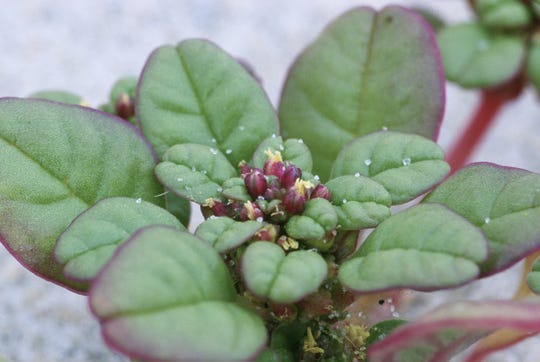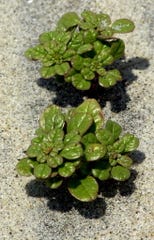Climate change and regulatory rollbacks spell doom for threatened and endangered species.
But along the New Jersey coastline, one species is making a comeback. Seabeach amaranth, an Atlantic Coast native once thought extirpated from the state, has rebounded despite long odds, Department of Environmental Protection Commissioner Catherine McCabe said recently.
Seabeach amaranth, a threatened species, is just one of six federally endangered or threatened plants in New Jersey. It’s an annual plant with short bunches of spinach-like leaves trimmed in light red, supported by fleshy red stalks.

Biologists from the state and the Conserve Wildlife Foundation of New Jersey counted 7,195 plants — a 600 percent increase — during the 2019 survey, conducted on beaches south of Sandy Hook.
More than 1,500 of the plants were found at Ocean County’s Island Beach State Park, state officials said. Just 300 were found at the park in 2018.
“The reaction is delight,” said Jay Kelly, a Raritan Valley Community College professor and state rare plants researcher who has studied seabeach amaranth for nearly two decades. “The work we’ve done is really paying off.”
Much of the success, Kelly said, has to do with the “cultural inertia of how we’re managing beaches.”
The primary threats to the rare plant are beach rakes and off-road vehicles, which can destroy habitat.
Now, all state parks and some coastal municipalities have staked off the back third of beaches. Those areas tend to be drier, hotter and less favorable for recreation — but they’re prime habitat for seabeach amaranth.
“You can satisfy recreation and natural resources,” Kelly said. “It’s not really impacting recreation at all.”

The plant protection areas have also helped piping plovers, which are threatened shorebirds that often nest in the places where seabeach amaranth grows. The two species have a symbiotic relationship, Kelly said.
The birds are just one of several populations that are coming back on their own thanks to a relatively cheap and simple beach management solution.
“I am very pleased that the statewide resurgence of seabeach amaranth experienced in 2018 has been far exceeded this year,” McCabe said. “While the increase can be the result of many different factors, it could not have occurred without the presence and structural integrity of the habitat required by this species.”
The U.S. Fish and Wildlife Service placed seabeach amaranth on the federal threatened species list in 1993.
But it disappeared from New Jersey long before that. Between 1913 and 2000, scientists couldn’t find any of the plants in the Garden State.
Two decades ago, it was rediscovered in Monmouth County. Its revival, researchers say, has been remarkable.
Kelly was the first to survey the plant when it reappeared. Starting in North Branch, he walked 120 miles, marking, measuring and recording plants from dawn to dusk. At night, he slept on the beach.
“It was really rewarding to get to know so intimately the entire length of a habitat,” he said. “It was really fascinating for me.”
That was Kelly’s strategy for seven years. These days, he has student interns helping with surveys.
But he still helps researchers in the field get access to places like Little Beach Island, believed to be the last uninhabited barrier island on the Atlantic coast — and which happens to be seabeach amaranth habitat.
Seabeach amaranth is usually found on overwash flats, parts of barrier beaches that are sparsely vegetated and heavy with pure sand, according to the U.S. Fish and Wildlife Service. In many areas, only a foot or two of beach are suitable habitat, Kelly said.
The plants don’t stay put, he added. Waves and wind scatter the plant’s seeds and inundate existing vegetation, making it tough to determine how much seabeach amaranth will spring up each year.
Sea level rise, warming temperatures and abnormal precipitation have affected the species — as have developments like riprap and seawalls designed to protect shoreline communities. And natural disasters can wipe out potential habitats in a single swipe.
“Staff of the Division of Parks and Forestry and its many partners and supporters should take a bow for their contribution to the resurgence of this very interesting and specialized plant,” said Parks and Forestry Director Olivia Glenn.
“Of course,” Glenn added, “if a little bit of luck was involved, we are thankful for that, too.”
Even with this year’s success, Kelly said, the initiative is in its early stages. In the future, researchers will focus on expanding available corridors of potential habitat.
“We’re hard-pressed to find conservation success stories,” Kelly said. “It’s just nice to have a win-win situation.”
Alexis Shanes is a local reporter for NorthJersey.com. For unlimited access to the most important news from your local community, please subscribe or activate your digital account today.
Email: shanesa@northjersey.com Twitter: @alexisjshanes
This story was produced in collaboration with the New Jersey Sustainability Reporting Hub project. It was originally reported by Alexis Shanes for northjersey.com, and may be re-distributed through the Creative Commons License, with attribution.
